Human Ecology Assignment: Sustainability, Pollution, and Footprints
VerifiedAdded on 2023/03/17
|5
|905
|64
Homework Assignment
AI Summary
This assignment delves into the core concepts of human ecology, exploring the three principles of sustainability: reliance on solar energy, chemical cycling, and biodiversity. It examines how society has deviated from these principles and proposes solutions for a return to sustainable practices. The assignment also defines ecological footprint and per capita ecological footprint, identifying cultural shifts that have intensified environmental degradation. Furthermore, it defines pollution, distinguishing between biodegradable and nondegradable pollutants, and analyzes the root causes of environmental problems, including population growth, unsustainable resource use, poverty, and the exclusion of environmental costs from market prices. The assignment concludes with a discussion on excluding environmental costs from market prices, using gasoline prices as an example.
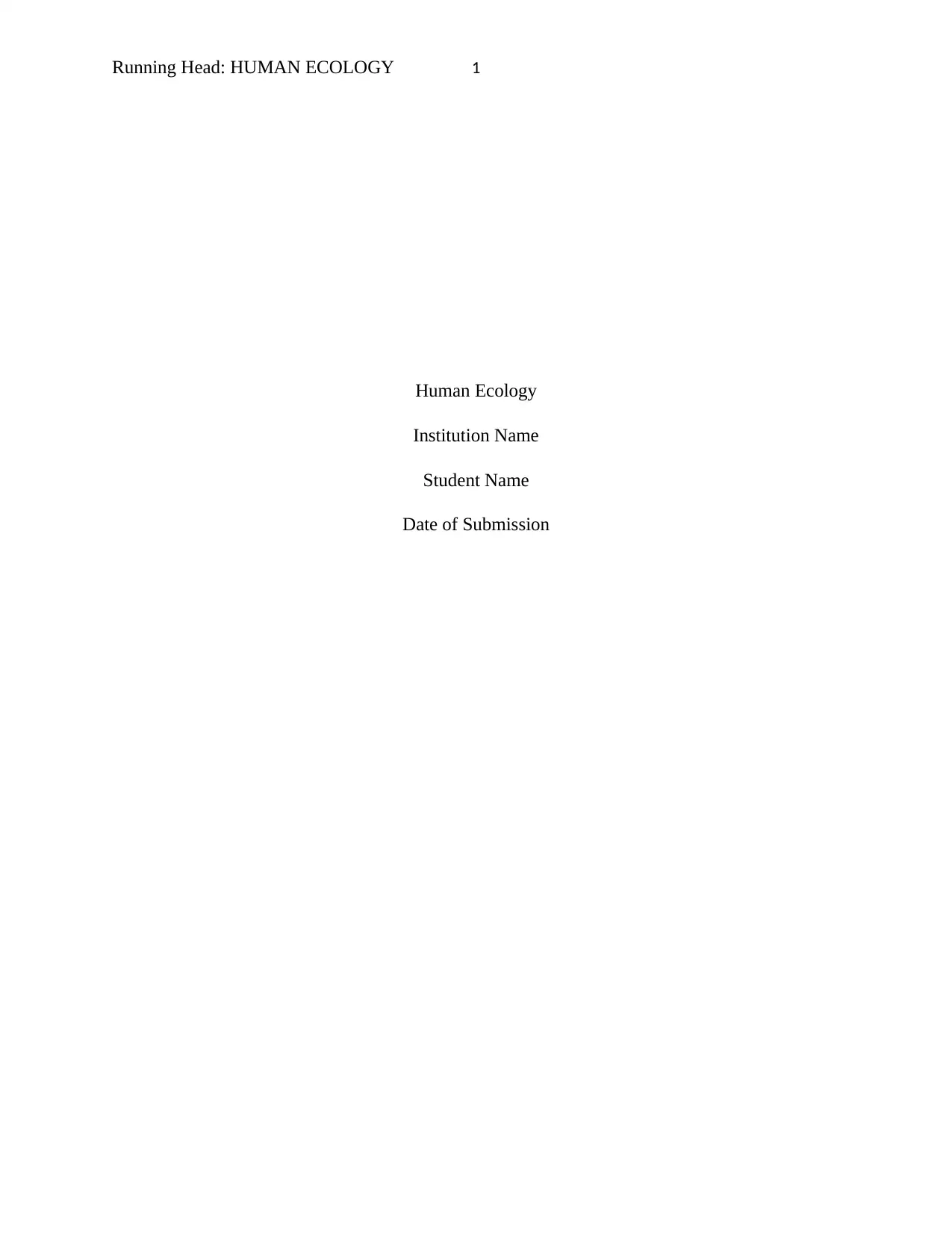
Running Head: HUMAN ECOLOGY 1
Human Ecology
Institution Name
Student Name
Date of Submission
Human Ecology
Institution Name
Student Name
Date of Submission
Paraphrase This Document
Need a fresh take? Get an instant paraphrase of this document with our AI Paraphraser
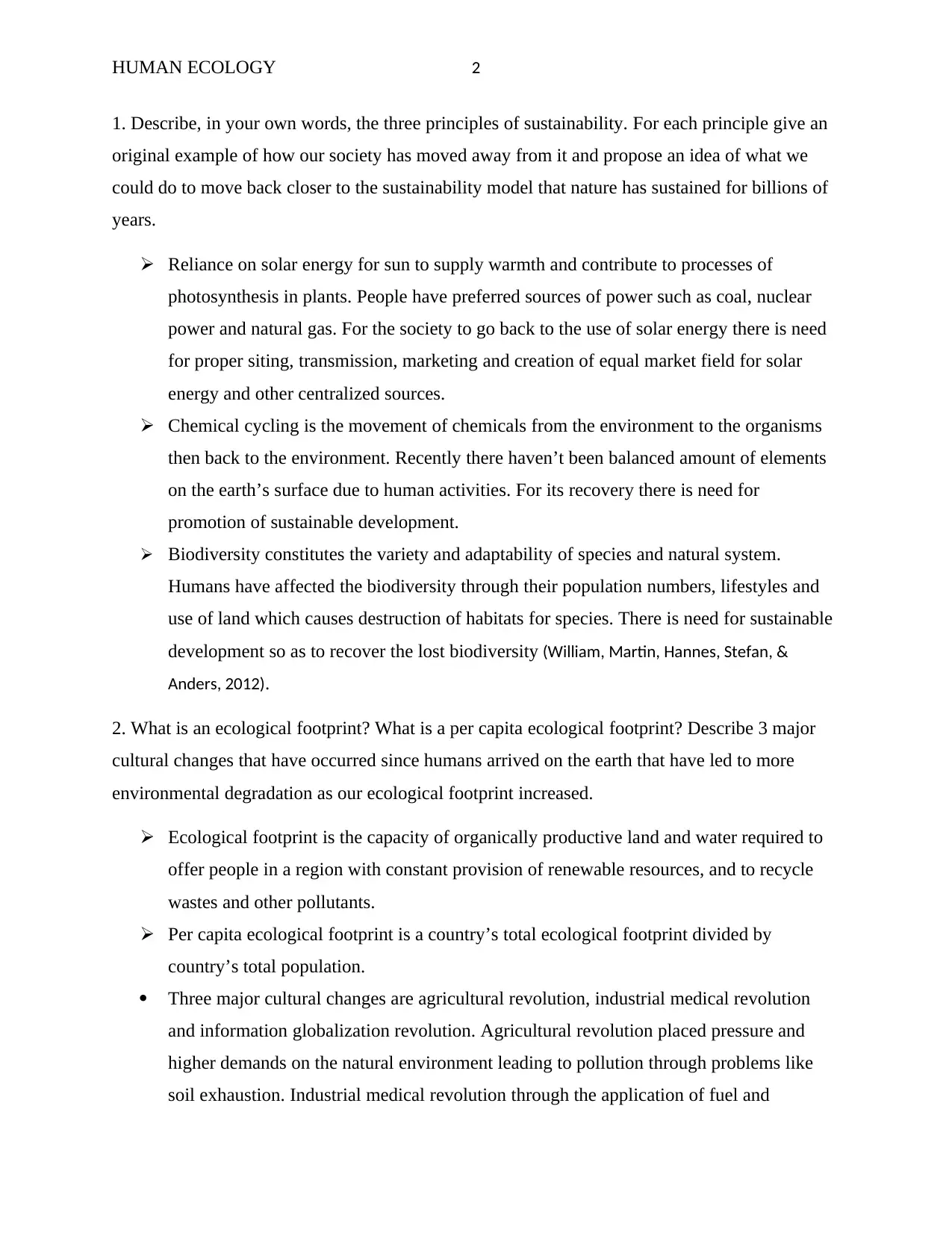
HUMAN ECOLOGY 2
1. Describe, in your own words, the three principles of sustainability. For each principle give an
original example of how our society has moved away from it and propose an idea of what we
could do to move back closer to the sustainability model that nature has sustained for billions of
years.
Reliance on solar energy for sun to supply warmth and contribute to processes of
photosynthesis in plants. People have preferred sources of power such as coal, nuclear
power and natural gas. For the society to go back to the use of solar energy there is need
for proper siting, transmission, marketing and creation of equal market field for solar
energy and other centralized sources.
Chemical cycling is the movement of chemicals from the environment to the organisms
then back to the environment. Recently there haven’t been balanced amount of elements
on the earth’s surface due to human activities. For its recovery there is need for
promotion of sustainable development.
Biodiversity constitutes the variety and adaptability of species and natural system.
Humans have affected the biodiversity through their population numbers, lifestyles and
use of land which causes destruction of habitats for species. There is need for sustainable
development so as to recover the lost biodiversity (William, Martin, Hannes, Stefan, &
Anders, 2012).
2. What is an ecological footprint? What is a per capita ecological footprint? Describe 3 major
cultural changes that have occurred since humans arrived on the earth that have led to more
environmental degradation as our ecological footprint increased.
Ecological footprint is the capacity of organically productive land and water required to
offer people in a region with constant provision of renewable resources, and to recycle
wastes and other pollutants.
Per capita ecological footprint is a country’s total ecological footprint divided by
country’s total population.
Three major cultural changes are agricultural revolution, industrial medical revolution
and information globalization revolution. Agricultural revolution placed pressure and
higher demands on the natural environment leading to pollution through problems like
soil exhaustion. Industrial medical revolution through the application of fuel and
1. Describe, in your own words, the three principles of sustainability. For each principle give an
original example of how our society has moved away from it and propose an idea of what we
could do to move back closer to the sustainability model that nature has sustained for billions of
years.
Reliance on solar energy for sun to supply warmth and contribute to processes of
photosynthesis in plants. People have preferred sources of power such as coal, nuclear
power and natural gas. For the society to go back to the use of solar energy there is need
for proper siting, transmission, marketing and creation of equal market field for solar
energy and other centralized sources.
Chemical cycling is the movement of chemicals from the environment to the organisms
then back to the environment. Recently there haven’t been balanced amount of elements
on the earth’s surface due to human activities. For its recovery there is need for
promotion of sustainable development.
Biodiversity constitutes the variety and adaptability of species and natural system.
Humans have affected the biodiversity through their population numbers, lifestyles and
use of land which causes destruction of habitats for species. There is need for sustainable
development so as to recover the lost biodiversity (William, Martin, Hannes, Stefan, &
Anders, 2012).
2. What is an ecological footprint? What is a per capita ecological footprint? Describe 3 major
cultural changes that have occurred since humans arrived on the earth that have led to more
environmental degradation as our ecological footprint increased.
Ecological footprint is the capacity of organically productive land and water required to
offer people in a region with constant provision of renewable resources, and to recycle
wastes and other pollutants.
Per capita ecological footprint is a country’s total ecological footprint divided by
country’s total population.
Three major cultural changes are agricultural revolution, industrial medical revolution
and information globalization revolution. Agricultural revolution placed pressure and
higher demands on the natural environment leading to pollution through problems like
soil exhaustion. Industrial medical revolution through the application of fuel and
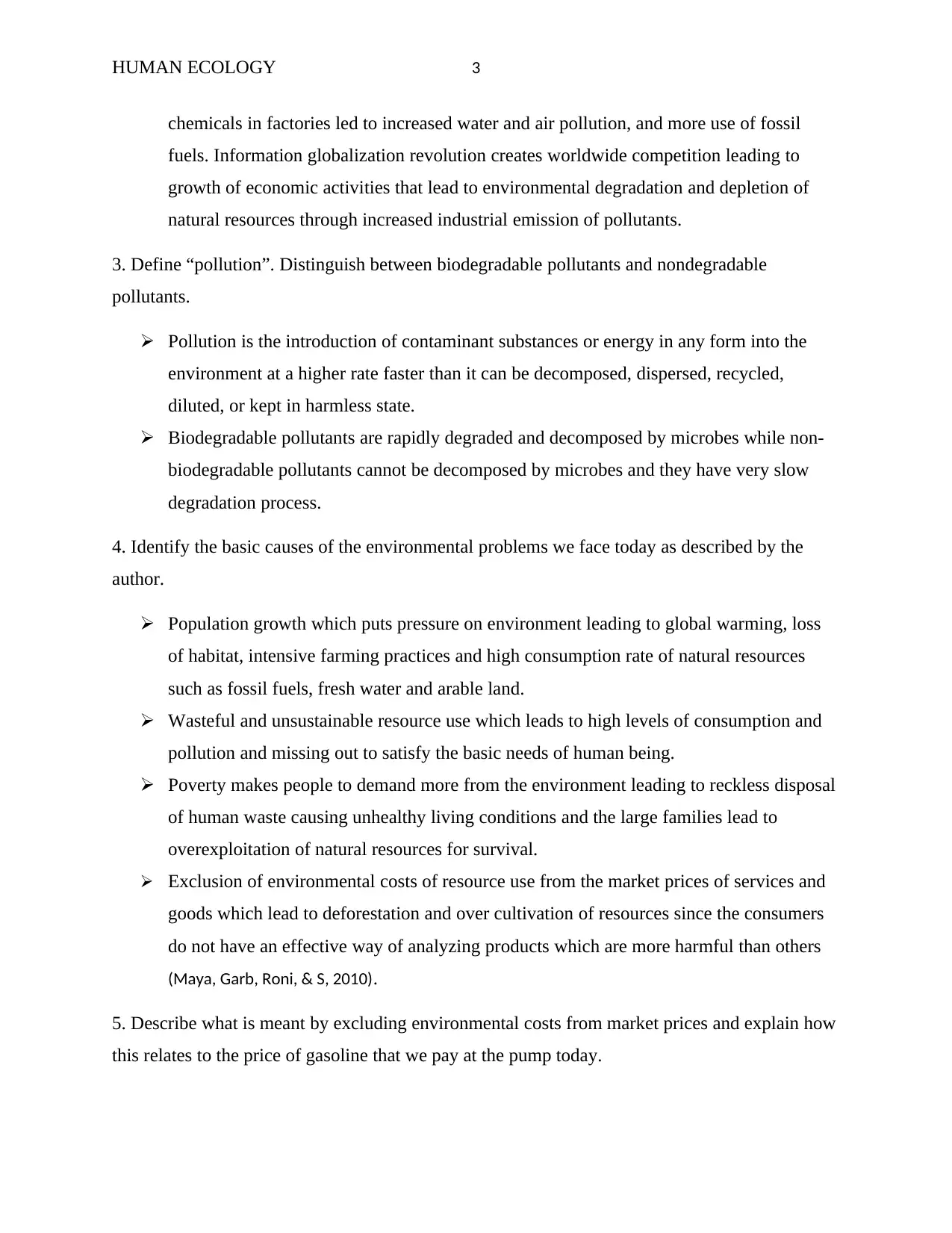
HUMAN ECOLOGY 3
chemicals in factories led to increased water and air pollution, and more use of fossil
fuels. Information globalization revolution creates worldwide competition leading to
growth of economic activities that lead to environmental degradation and depletion of
natural resources through increased industrial emission of pollutants.
3. Define “pollution”. Distinguish between biodegradable pollutants and nondegradable
pollutants.
Pollution is the introduction of contaminant substances or energy in any form into the
environment at a higher rate faster than it can be decomposed, dispersed, recycled,
diluted, or kept in harmless state.
Biodegradable pollutants are rapidly degraded and decomposed by microbes while non-
biodegradable pollutants cannot be decomposed by microbes and they have very slow
degradation process.
4. Identify the basic causes of the environmental problems we face today as described by the
author.
Population growth which puts pressure on environment leading to global warming, loss
of habitat, intensive farming practices and high consumption rate of natural resources
such as fossil fuels, fresh water and arable land.
Wasteful and unsustainable resource use which leads to high levels of consumption and
pollution and missing out to satisfy the basic needs of human being.
Poverty makes people to demand more from the environment leading to reckless disposal
of human waste causing unhealthy living conditions and the large families lead to
overexploitation of natural resources for survival.
Exclusion of environmental costs of resource use from the market prices of services and
goods which lead to deforestation and over cultivation of resources since the consumers
do not have an effective way of analyzing products which are more harmful than others
(Maya, Garb, Roni, & S, 2010).
5. Describe what is meant by excluding environmental costs from market prices and explain how
this relates to the price of gasoline that we pay at the pump today.
chemicals in factories led to increased water and air pollution, and more use of fossil
fuels. Information globalization revolution creates worldwide competition leading to
growth of economic activities that lead to environmental degradation and depletion of
natural resources through increased industrial emission of pollutants.
3. Define “pollution”. Distinguish between biodegradable pollutants and nondegradable
pollutants.
Pollution is the introduction of contaminant substances or energy in any form into the
environment at a higher rate faster than it can be decomposed, dispersed, recycled,
diluted, or kept in harmless state.
Biodegradable pollutants are rapidly degraded and decomposed by microbes while non-
biodegradable pollutants cannot be decomposed by microbes and they have very slow
degradation process.
4. Identify the basic causes of the environmental problems we face today as described by the
author.
Population growth which puts pressure on environment leading to global warming, loss
of habitat, intensive farming practices and high consumption rate of natural resources
such as fossil fuels, fresh water and arable land.
Wasteful and unsustainable resource use which leads to high levels of consumption and
pollution and missing out to satisfy the basic needs of human being.
Poverty makes people to demand more from the environment leading to reckless disposal
of human waste causing unhealthy living conditions and the large families lead to
overexploitation of natural resources for survival.
Exclusion of environmental costs of resource use from the market prices of services and
goods which lead to deforestation and over cultivation of resources since the consumers
do not have an effective way of analyzing products which are more harmful than others
(Maya, Garb, Roni, & S, 2010).
5. Describe what is meant by excluding environmental costs from market prices and explain how
this relates to the price of gasoline that we pay at the pump today.
⊘ This is a preview!⊘
Do you want full access?
Subscribe today to unlock all pages.

Trusted by 1+ million students worldwide
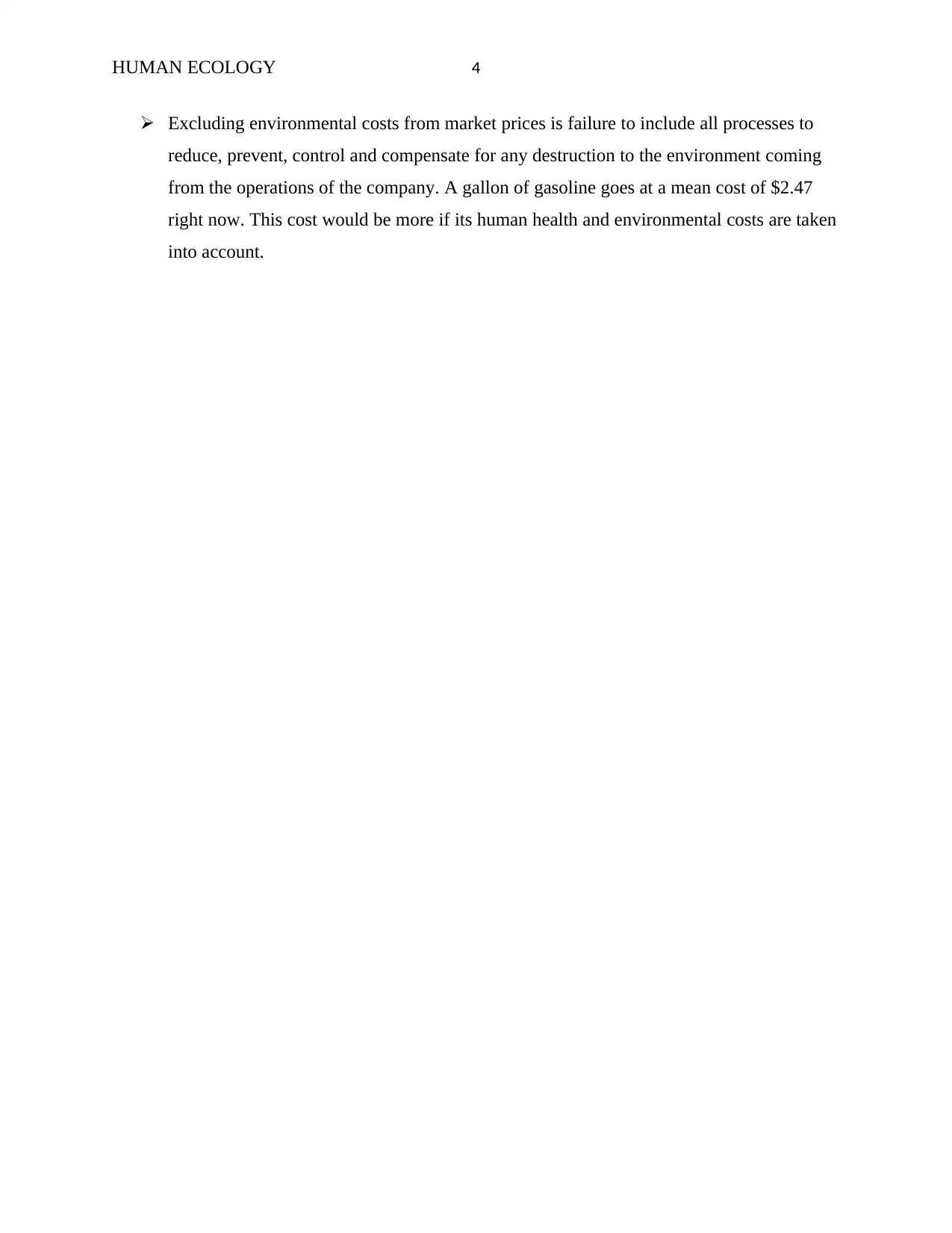
HUMAN ECOLOGY 4
Excluding environmental costs from market prices is failure to include all processes to
reduce, prevent, control and compensate for any destruction to the environment coming
from the operations of the company. A gallon of gasoline goes at a mean cost of $2.47
right now. This cost would be more if its human health and environmental costs are taken
into account.
Excluding environmental costs from market prices is failure to include all processes to
reduce, prevent, control and compensate for any destruction to the environment coming
from the operations of the company. A gallon of gasoline goes at a mean cost of $2.47
right now. This cost would be more if its human health and environmental costs are taken
into account.
Paraphrase This Document
Need a fresh take? Get an instant paraphrase of this document with our AI Paraphraser
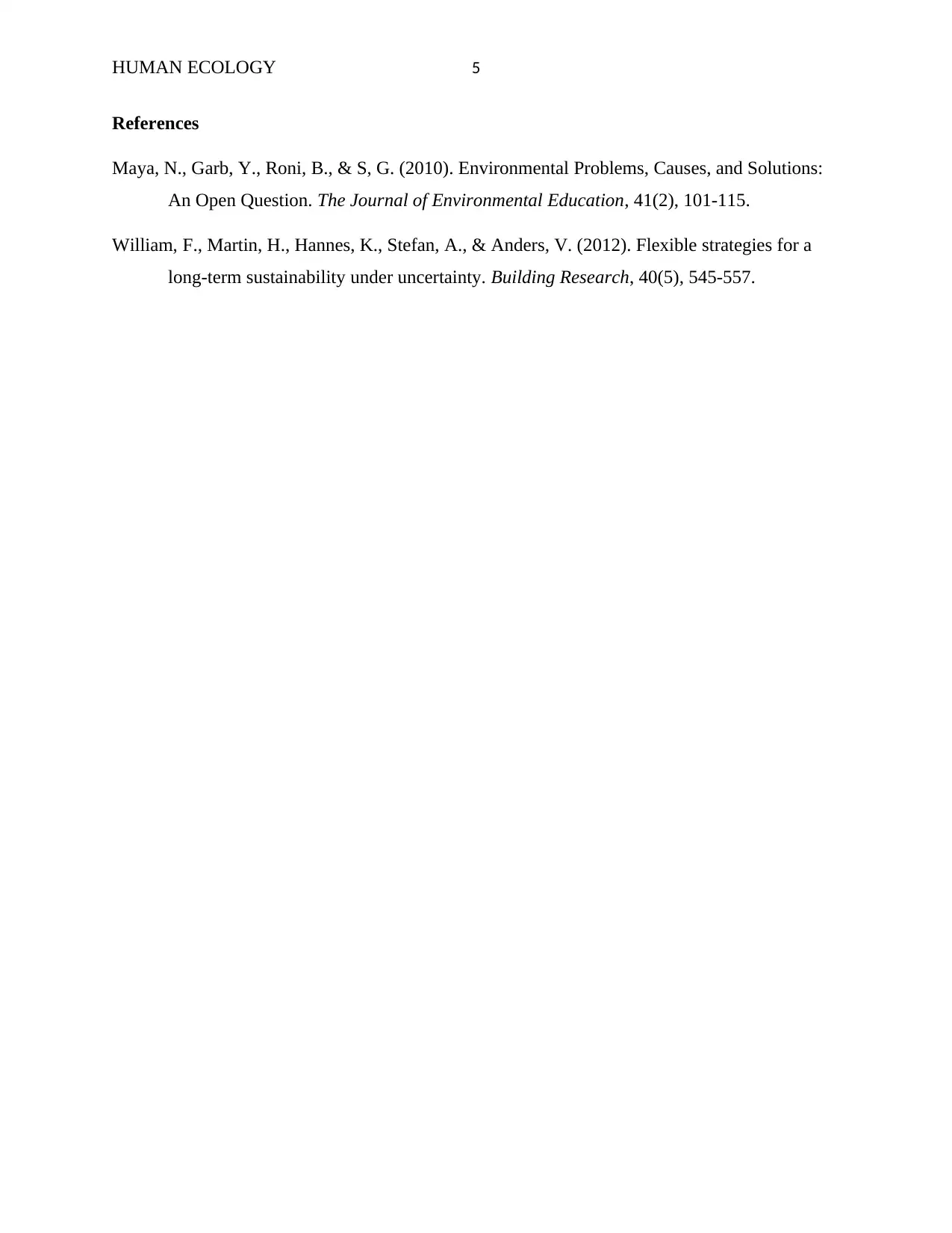
HUMAN ECOLOGY 5
References
Maya, N., Garb, Y., Roni, B., & S, G. (2010). Environmental Problems, Causes, and Solutions:
An Open Question. The Journal of Environmental Education, 41(2), 101-115.
William, F., Martin, H., Hannes, K., Stefan, A., & Anders, V. (2012). Flexible strategies for a
long-term sustainability under uncertainty. Building Research, 40(5), 545-557.
References
Maya, N., Garb, Y., Roni, B., & S, G. (2010). Environmental Problems, Causes, and Solutions:
An Open Question. The Journal of Environmental Education, 41(2), 101-115.
William, F., Martin, H., Hannes, K., Stefan, A., & Anders, V. (2012). Flexible strategies for a
long-term sustainability under uncertainty. Building Research, 40(5), 545-557.
1 out of 5
Related Documents
Your All-in-One AI-Powered Toolkit for Academic Success.
+13062052269
info@desklib.com
Available 24*7 on WhatsApp / Email
![[object Object]](/_next/static/media/star-bottom.7253800d.svg)
Unlock your academic potential
Copyright © 2020–2025 A2Z Services. All Rights Reserved. Developed and managed by ZUCOL.





